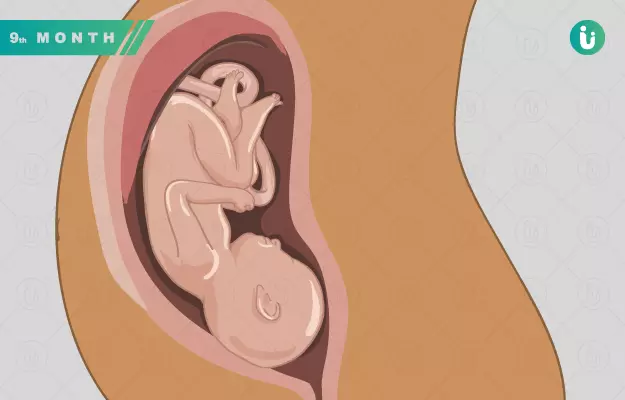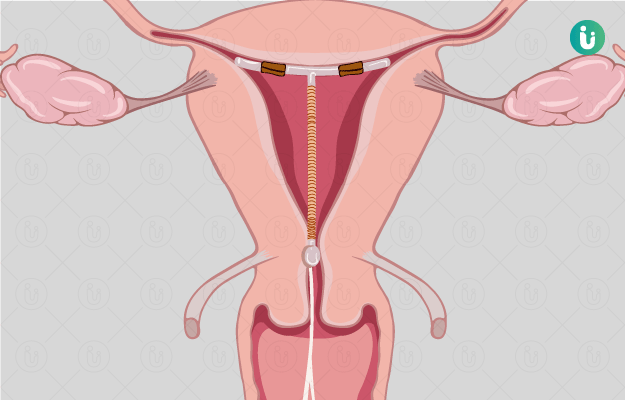During the ninth month of pregnancy, you will most likely experience all the symptoms you experienced in the earlier months, just more severe. As the baby grows in size, it exerts more and more pressure on the pelvis, which accentuates the symptoms of increased urination. How hard must it be to rush to the loo several times with that big belly?
Talking of the belly, the linea nigra running down vertically is quite dark and you also acquire a few more stretch marks as your child gains fat and your belly grows to accommodate. But, these symptoms will most likely go after delivery with proper care. For now, you can have more water and regularly hydrate your skin with the help of topical lotions and oils.
(Read more: How to remove stretch marks)
Other than your belly, your breasts will also continue to grow and will feel more tender. Colostrum is already formed by now to be available after childbirth. It is likely that it may leak from your tender and swollen breasts.
(Read more: Breast changes in early and late pregnancy)
Vaginal leak or discharge is also common at this stage.
The symptoms of heartburn, constipation and indigestion are likely to improve in some women as the baby drops lower in the uterus closer to delivery. But, if the foetus stays high as it was before, these symptoms won’t improve.
All trivial when compared to the joys of childbirth?
But, what about the excruciating pain you experience all over your body and the immense fatigue? The pain experienced in your back, abdomen, thighs and buttocks is due to the pressure exerted by the growing baby. It is not a matter of concern, just like the contractions experienced in the abdomen. Similar to the contractions experienced during labour, these only last for a few seconds and help in preparing your body for childbirth.
It is recommended to have more water if these contractions are experienced often since these are triggered by dehydration. This will also help in reducing fatigue. Why you experience so much fatigue is because of all the extra weight that you are carrying. Another reason for fatigue could be the disturbance in sleep you commonly experience in late pregnancy.
(Read more: Sleep during pregnancy)
The foetus, which is big enough by now exerts pressure on your lungs, making you feel breathless.
The growing uterus also exerts pressure on your stomach and pushes it upwards. This causes you to eat lesser because you feel full earlier. The pressure on the stomach and the oesophagus can also cause reflux symptoms. Having smaller and more frequent meals and opting for calorie-dense foods with a low volume is recommended to keep up with the nutritional levels despite these feelings.
Another common symptom during the end of pregnancy is swollen feet and ankles. This is because of oedema and change in the blood supply, causing you to retain more fluids within this area. To avoid this, it is advisable to avoid standing for long hours. Take breaks and sit in between. But, the best way to manage this is by keeping your legs high. You don’t have to keep them up straight, just, place them a bit higher on a pillow or a support. This will aid in the venous return diminishing the swelling.
If you commonly experience disturbed sleep, it is suggested to find a comfortable sleeping position. With the big size of the belly, it is best to sleep on your side. Sleeping on your back will be uncomfortable during this time causing back pain. Sleeping on your stomach will harm your baby. While sleeping on the side, you can make the use of a pillow for better comfort. Insert the pillow in between your legs or under the bump. Try several positions to see which one helps. Other than this, having a warm shower or a cup of milk may help. All these measures will also help in relieving back pain or pain in the buttocks, providing additional relief.
The above symptoms are commonly experienced by women during the ninth month of pregnancy and are not matters of medical concern. However, if the symptoms are severe, it is recommended to visit a doctor. Severely swollen legs could be a sign of preeclampsia. Similarly, frequent micturition holds the risk of urinary tract infection, which is common during pregnancy. It is best to visit a doctor and get yourself diagnosed and treated if the problems are immensely severe.










































